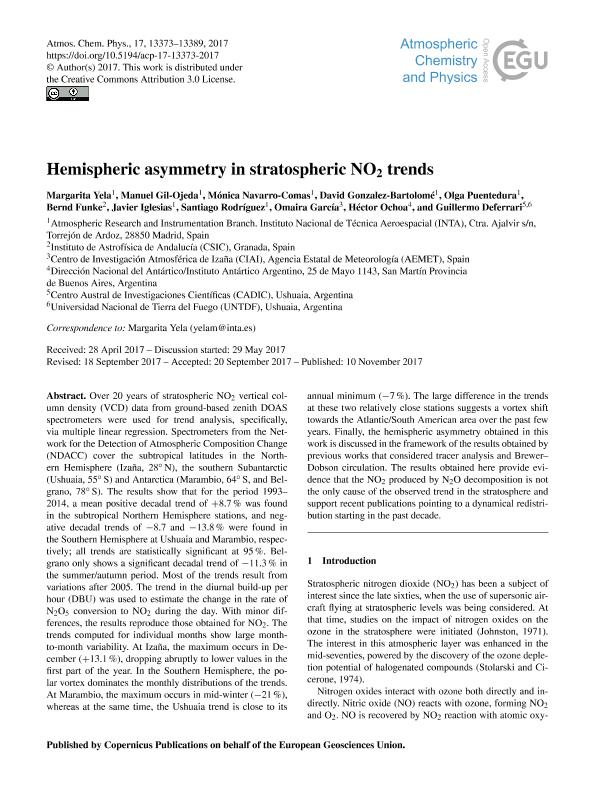Mostrar el registro sencillo del ítem
dc.contributor.author
Yela, Margarita
dc.contributor.author
Gil-Ojeda, Manuel
dc.contributor.author
Navarro-Comas, Mónica
dc.contributor.author
Gonzalez-Bartolomé, David
dc.contributor.author
Puentedura, Olga
dc.contributor.author
Funke, Bernd
dc.contributor.author
Iglesias, Javier
dc.contributor.author
Rodríguez, Santiago
dc.contributor.author
García, Omaira
dc.contributor.author
Ochoa, Héctor
dc.contributor.author
Deferrari, Guillermo Alejandro

dc.date.available
2018-11-05T20:34:43Z
dc.date.issued
2017-11
dc.identifier.citation
Yela, Margarita; Gil-Ojeda, Manuel; Navarro-Comas, Mónica; Gonzalez-Bartolomé, David; Puentedura, Olga; et al.; Hemispheric asymmetry in stratospheric NO2 trends; Copernicus Publications; Atmospheric Chemistry and Physics; 17; 21; 11-2017; 13373-13389
dc.identifier.issn
1680-7316
dc.identifier.uri
http://hdl.handle.net/11336/63702
dc.description.abstract
Over 20 years of stratospheric NO2 vertical column density (VCD) data from ground-based zenith DOAS spectrometers were used for trend analysis, specifically, via multiple linear regression. Spectrometers from the Network for the Detection of Atmospheric Composition Change (NDACC) cover the subtropical latitudes in the Northern Hemisphere (Izaña, 28° N), the southern Subantarctic (Ushuaia, 55° S) and Antarctica (Marambio, 64° S, and Belgrano, 78° S). The results show that for the period 1993-2014, a mean positive decadal trend of +8.7 % was found in the subtropical Northern Hemisphere stations, and negative decadal trends of-8.7 and-13.8 % were found in the Southern Hemisphere at Ushuaia and Marambio, respectively; all trends are statistically significant at 95 %. Belgrano only shows a significant decadal trend of-11.3 % in the summer/autumn period. Most of the trends result from variations after 2005. The trend in the diurnal build-up per hour (DBU) was used to estimate the change in the rate of N2O5 conversion to NO2 during the day. With minor differences, the results reproduce those obtained for NO2. The trends computed for individual months show large month-to-month variability. At Izaña, the maximum occurs in December (+13.1 %), dropping abruptly to lower values in the first part of the year. In the Southern Hemisphere, the polar vortex dominates the monthly distributions of the trends. At Marambio, the maximum occurs in mid-winter (-21 %), whereas at the same time, the Ushuaia trend is close to its annual minimum (-7 %). The large difference in the trends at these two relatively close stations suggests a vortex shift towards the Atlantic/South American area over the past few years. Finally, the hemispheric asymmetry obtained in this work is discussed in the framework of the results obtained by previous works that considered tracer analysis and Brewer-Dobson circulation. The results obtained here provide evidence that the NO2 produced by N2O decomposition is not the only cause of the observed trend in the stratosphere and support recent publications pointing to a dynamical redistribution starting in the past decade.
dc.format
application/pdf
dc.language.iso
eng
dc.publisher
Copernicus Publications

dc.rights
info:eu-repo/semantics/openAccess
dc.rights.uri
https://creativecommons.org/licenses/by-nc-sa/2.5/ar/
dc.subject
Atmosfera
dc.subject
Stratospheric
dc.subject
No2
dc.subject
Trends
dc.subject.classification
Meteorología y Ciencias Atmosféricas

dc.subject.classification
Ciencias de la Tierra y relacionadas con el Medio Ambiente

dc.subject.classification
CIENCIAS NATURALES Y EXACTAS

dc.title
Hemispheric asymmetry in stratospheric NO2 trends
dc.type
info:eu-repo/semantics/article
dc.type
info:ar-repo/semantics/artículo
dc.type
info:eu-repo/semantics/publishedVersion
dc.date.updated
2018-10-19T20:40:03Z
dc.identifier.eissn
1680-7324
dc.journal.volume
17
dc.journal.number
21
dc.journal.pagination
13373-13389
dc.journal.pais
Alemania

dc.journal.ciudad
Gottingen
dc.description.fil
Fil: Yela, Margarita. Instituto Nacional de Tecnica Aeroespacial; España
dc.description.fil
Fil: Gil-Ojeda, Manuel. Instituto Nacional de Tecnica Aeroespacial; España
dc.description.fil
Fil: Navarro-Comas, Mónica. Instituto Nacional de Tecnica Aeroespacial; España
dc.description.fil
Fil: Gonzalez-Bartolomé, David. Instituto Nacional de Tecnica Aeroespacial; España
dc.description.fil
Fil: Puentedura, Olga. Instituto Nacional de Tecnica Aeroespacial; España
dc.description.fil
Fil: Funke, Bernd. Instituto de Astrofísica de Andalucía; España
dc.description.fil
Fil: Iglesias, Javier. Instituto Nacional de Tecnica Aeroespacial; España
dc.description.fil
Fil: Rodríguez, Santiago. Instituto Nacional de Tecnica Aeroespacial; España
dc.description.fil
Fil: García, Omaira. Centro de Investigación Atmosférica de Izaña; España
dc.description.fil
Fil: Ochoa, Héctor. Ministerio de Relaciones Exteriores, Comercio Interno y Culto. Dirección Nacional del Antártico. Instituto Antártico Argentino; Argentina
dc.description.fil
Fil: Deferrari, Guillermo Alejandro. Consejo Nacional de Investigaciones Científicas y Técnicas. Centro Austral de Investigaciones Científicas; Argentina. Universidad Nacional de Tierra del Fuego; Argentina
dc.journal.title
Atmospheric Chemistry and Physics

dc.relation.alternativeid
info:eu-repo/semantics/altIdentifier/doi/http://dx.doi.org/10.5194/acp-17-13373-2017
dc.relation.alternativeid
info:eu-repo/semantics/altIdentifier/url/https://www.atmos-chem-phys.net/17/13373/2017/
Archivos asociados
